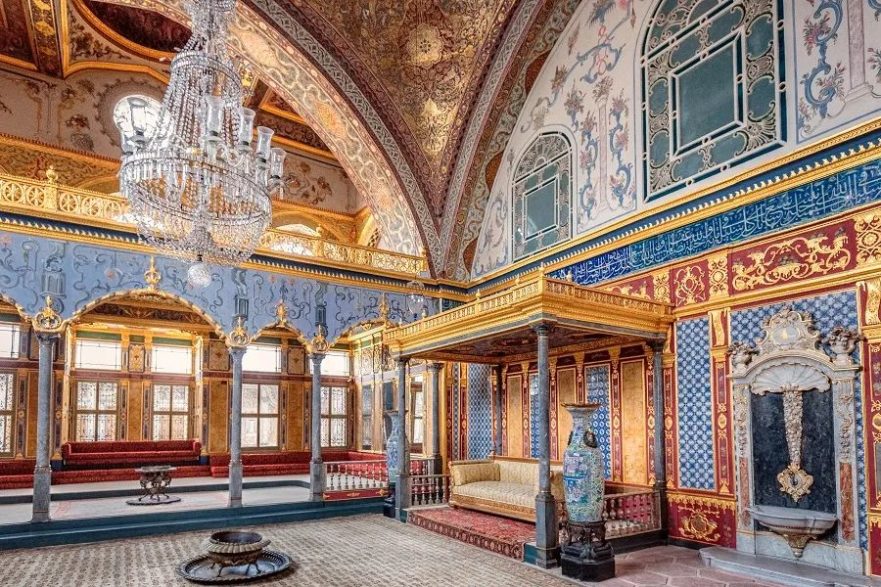2022年9月劳伦斯·保罗女士从伦敦飞到了土耳其,在土耳其伊斯坦布尔参观了著名的托普卡匹皇宫博物馆。
In September 2022, Laurence Paul flew from London to Turkey, where she visited the famous Chinese porcelain collection in Topkapi Palace Museum in Istanbul.
托普卡匹皇宫博物馆展出了近12000件中国瓷器藏品,不间断地揭示了13世纪至19世纪中国瓷器演变的历史年表。
A nearly 12,000-piece collection of Chinese porcelain is on display in the Topkapi Palace Museum, revealing an uninterrupted historical chronology of the evolution of Chinese porcelains from the 13th to the 19th century.
托普卡匹皇宫最初由君士坦丁堡的征服者苏丹穆罕默德二世于1460年至1478年间建造,并在其悠长历史中多次被扩建和被改造。
The Topkapi Palace originally built between 1460 and 1478 by Sultan Mehmed II, the conqueror of Constantinople, and has been enlarged and remodelled several times during its long history.
直到19世纪中叶,托普卡匹皇宫一直是奥斯曼帝国苏丹及其宫廷的所在地。
Until the mid-19th century, the Ottoman Sultan and his court located in the Topkapi Palace.
1922年废除了奥斯曼君主制后,托普卡匹皇宫于1924年4月3日由Mustafa Kemal Atatürk下令改建为博物馆。
After the abolition of the Ottoman monarchy in 1922, the Topkapi Palace was converted into a museum by order of Mustafa Kemal Atatürk on 3 April 1924.
托普卡匹皇宫厨房占地超过5,250平方米,在奥斯曼帝国的鼎盛时期曾经每天为5,000多人提供食物。
Spanning over an area of over 5,250 square meters, a palace kitchen in Istanbul’s European side was once feeding over 5,000 people per day, during the heydays of the Ottoman Empire.
为了使宫廷厨房和餐桌更加富丽堂皇,13世纪的奥斯曼苏丹开始收集最精美的中国瓷器。
In order to make the court kitchens and tables more opulent, the Ottoman sultans of the 13th century began collecting the finest Chinese porcelain.
所有的瓷器每天都在被使用,而不仅仅是用于展示, 这些瓷器是他们唯一用来装食物的容器。
All the porcelain were using every day and not just for displayed. It was the only containers they had for food.
咖啡对于土耳其人来说是非常重要的。尽管在19世纪,土耳其宫廷咖啡文化依旧以传统的方式继续,但贵族会在日常生活中使用由咖啡杯、杯托和咖啡壶组成的中国瓷器咖啡用具套装。
The coffee was very important in Turkey. Although coffee culture at the palace continued in the traditional manner during 19th century, consisting of coffee cups, cup holders and coffee jugs, Chinese porcelain coffee sets were used in their daily life.
果酱在宫廷生活中也占有重要地位。奥斯曼帝国的苏丹还有专门厨房,制作果酱、果汁和糖果。劳伦斯女士在参观结束后,受到展览的启发,自己开始尝试用土耳其的新鲜草莓制作果酱。
Jam also had an important place in court life. The Ottoman sultans had special kitchen for making jams, juices and sweets. Inspired by the exhibition, Mrs Laurence Paul began making jam using fresh strawberries from Turkey by herself.
历史学家认为,奥斯曼宫殿中实际使用的中国瓷器数量超过10万件,但其中大部分在几次地震和火灾中丢失或毁坏。
Historians believe that the actual number of Chinese porcelains used in the Ottoman palaces was over 100,000, but most of them were lost or destroyed in several earthquakes and fires.
其中一些藏品是高级官员或外交使团赠送的礼物,但其中很大一部分,是通过古代丝绸之路,从中国运到奥斯曼宫殿中的。
Some of these pieces were presented as gifts from high-level state men or foreign diplomatic missions, and a significant part of the collection was transferred from China to the palaces through the ancient Silk Road.
直到1700年代初,中国是世界上唯一的瓷器生产国,中国生产的瓷器非常昂贵,在当时被称为“白金”。
Until the early 1700s, China was the only porcelain producer in the world, and the pieces it produced were very precious known as White Gold.
在宫廷厨房中,最受欢迎的中国瓷器类型之一是青瓷,因为土耳其人认为青瓷有验毒的功能。如果食物里被加入了毒药,用青瓷装盛后,青瓷会变色或破裂。
One of the most preferred types of Chinese porcelains in the palace kitchens was celadons because they were believed to change colour or get cracked when poison was added.
16世纪后期,奥斯曼苏丹定制和购买了许多绘制有古兰经经文的青花瓷用作餐具。
In the late 16th century, the Ottoman sultans customised and purchased many porcelains with Qur’anic verses for use as tableware.
从19世纪开始,土耳其艺术家通过模仿和再创造,也自己尝试制作了许多瓷器,其中大部分灵感来自中国的青花瓷。
From the 19th century, Turkish artists, through imitation and reinvention, also experimented with their own porcelain. Most of them inspired by Chinese blue and white porcelain.
托普卡匹皇宫博物馆收藏的中国瓷器,包含了宋、元、明、清时期的青瓷、青花瓷、单色瓷、彩色瓷共约一万多件中国瓷器收藏。
The collection of Chinese porcelain in the Topkapi Palace Museum includes over 10,000 pieces of celadon, blue and white, monochrome and coloured porcelain from the Song, Yuan, Ming and Qing dynasties.
托普卡匹皇宫博物馆收藏的中国瓷器,是当今海外博物馆中数量最多,价值最高的收藏之一。
The collection of Chinese porcelain in the Topkapi Palace Museum is one of the largest and most valuable collections in overseas museums today.
托普卡匹皇宫藏品囊括了13至20世纪初中国销往奥斯曼帝国兼中近东各伊斯兰国家的各种瓷器。
The collection of the Topkapi Palace includes a wide range of porcelain from China to the Ottoman Empire and the Islamic countries of the Middle East from the 13th to the early 20th century.
托普卡匹皇宫藏品是中国陶瓷生产、制造和远销贸易历史与发展的重要佐证。
The Topkapi Palace Collection is an important testimony to the history and development of Chinese ceramic production, manufacture and export trade.
参考资料References:
1.联合国教科文组织:https://zh.unesco.org/silkroad/content/tuopukapagongbowuguan
2.Chinese porcelains used in Ottoman palace on display in Istanbul: https://www.chinadaily.com.cn/a/202010/06/WS5f7c2e99a31024ad0ba7d505.html
3.TOPKAPI PALACE MUSEUM: https://muze.gen.tr/muze-detay/topkapi












































